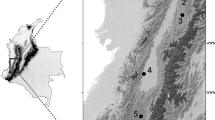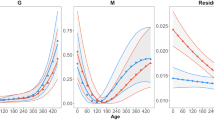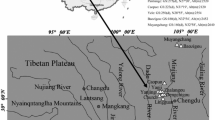Abstract
Genetic and environmental sources of egg size, fecundity and body size (forewing length) were examined in the butterfly, Parnara guttata guttata. Phenotypic and genetic correlation and heritability were estimated for these traits under different day-length and temperature conditions. Egg size and fecundity had relatively high heritabilities, and body sizes in males and females had moderate and high heritability, respectively. Negative phenotypic and genetic correlations between egg size and fecundity were estimated in treatments corresponding to the natural conditions during larval development of the first and second generations. Phenotypic and genetic correlations between body size and egg size differed considerably between insects reared under long and short day-lengths. Next, genotype–environment interactions were estimated by comparing reaction norms to day-length or temperature of these traits among families. ANOVA analysis revealed significant genotype–environment interactions in egg size and forewing length in both sexes for day-length and temperature. These results suggested that a large additive genetic variance for egg size might have been maintained by a genetic trade-off and/or by genotype–environment interactions in P. g. guttata.

Similar content being viewed by others
References
Ayala J, Campbell CA (1974) Frequency dependent selection. Annu Rev Ecol Evol Syst 5:115–138
Blanckenhorn WU (1998) Adaptive phenotypic plasticity in growth, development, and body size in the yellow dung fly. Evolution 52:1394–1407
Bochdanovits Z, de Jong G (2004) Antagonistic pleiotropy for life-history traits at the gene expression level. Proc R Soc London B (Suppl) 271:S75–S78
Braby MF (1994) The significance of egg size variation in butterflies in relation to hostplant quality. Oikos 71:119–129
Brakefield PM, Kesbeke F (1997) Genotype–environment interactions for insect growth in constant and fluctuating temperature regimes. Proc R Soc London B 264:717–723
Bulmer MG (1971) Stable equilibria under the two island model. Heredity 27:321–330
Campbell DR (1997) Genetic and environmental variation in life-history traits of a monocarpic perennial: a decade-long field experiment. Evolution 51:373–382
Capinera JL (1979) Quantitative variation in plants and insects: effect of propagule size on ecological plasticity. Am Nat 114:350–361
Clarke BC (1979) The evolution of genetic diversity. Proc R Soc London B 205:453–474
Crump ML (1981) Variation in propagule size as a function of environmental uncertainty for tree frogs. Am Nat 117:724–737
Cummins CP (1986) Temporal and spatial variation in egg size and fecundity in Rana temporaria. J Anim Ecol 55:303–316
Curtsinger JW, Service PM, Prout T (1994) Antagonistic pleiotropy, reversal of dominance, and genetic polymorphism. Am Nat 144:210–228
Czesak ME, Fox CW (2003) Evolutionary ecology of egg size and number in a seed beetle: genetic trade-off differs between environments. Evolution 57:1121–1132
Ebert D (1993) The trade-off between offspring size and number in Daphnia magna: the influence of genetic, environmental and maternal effects. Arch Hydrobiol 4:453–473
Endler JA (1988) Frequency-dependent predation, crypsis and aposematic coloration. Philos Trans R Soc London B 319:505–523
Falconer DS, Mackay TFC (1996) Introduction to quantitative genetics, 4th edn. Longman, London
Fischer K, Fiedler K (2001) Egg weight variation in the butterfly Lycaena hippothoe: more small or fewer large eggs? Popul Ecol 43:105–109
Fischer K, Bot ANM, Zwaan BJ, Brakefield PM (2004) Genetic and environmental sources of egg size variation in the butterfly Bicyclus anynana. Heredity 92:163–169
Fox CW (1997) Egg-size manipulations in the seed beetle Stator limbatus: consequences for progeny growth. Can J Zool 75:1465–1473
Fox CW, Czesak ME, Mousseau TA, Roff DA (1999) The evolutionary genetics of an adaptive maternal effect: egg size plasticity in a seed beetle. Evolution 53:552–560
Fry JD, Heinsohn SL, Mackay TFC (1996) The contribution of new mutations to genotype–environment interaction for fitness in Drosophila melanogaster. Evolution 50:2316–2327
Gillespie JH, Turelli M (1989) Genotype–environment interactions and the maintenance of polygenic variation. Genetics 121:129–138
Hareyama M, Tsukuda R, Nakasuji F (1991) Environmental and genetic factors determining the egg size of a migrant skipper Parnara guttata guttata (Lepidoptera: Hesperiidae) (in Japanese with English summary). Chûgoku Kontyû 5:7–14
Heath DD, Fox CW, Heath JW (1999) Maternal effects on offspring size: variation through early development of chinook salmon. Evolution 53:1605–1611
Hiura I (1973) Butterflies migrating over sea (in Japanese). Sôju Shobô, Tokyo
Ishii M, Hidaka T (1979) Seasonal polymorphism of the adult rice-plant skipper, Parnara guttata guttata (Lepidoptera: Hesperiidae) and its control. Appl Entomol Zool 14:173–184
Janzen DH (1977) Variation in seed size within a crop of a Costa Rican Micuna andreana (Leguminosae). Am J Bot 64:347–349
Kaplan RH (1980) The implications of ovum size variability for offspring fitness and clutch size within several populations of salamanders (Ambystoma). Evolution 34:51–64
Lande R (1975) The maintenance of genetic variation by mutation in a polygenic character with linked loci. Genet Res 26:221–235
Levene H (1953) Genetic equilibrium when more than one ecological niche is available. Am Nat 87:331–333
Lewontin RC, Ginsburg LR, Taljaparkar SD (1978) Heterosis as an explanation for large amounts of genetic polymorphism. Genetics 88:149–170
Lynch M, Walsh B (1998) Genetics and analysis of quantitative traits. Sinauer, Sunderland, MA
McGinley MA, Temme DH, Geber MA (1987) Parental investment in offspring in variable environments: theoretical and empirical considerations. Am Nat 130:370–398
Mitchell-Olds T, Bradley D (1996) Genetics of Brassica rapa. 3. Costs of disease resistance to three fungal pathogens. Evolution 50:1859–1865
Nakasuji F (1982) Seasonal changes in native host plants of a migrant skipper, Parnara guttata Bremer et grey (Lepidoptera, Hesperiidae). Appl Entomol Zool 17:146–148
Nakasuji F (1987) Egg size of skippers (Lepidoptera: Hesperiidae) in relation to their host specificity and to leaf toughness of host plants. Ecol Res 2:175–183
Nakasuji F, Honda H (1979) A simple method for mass-rearing of the rice skipper, Parnara guttata guttata Bremer et grey (Lepidoptera, Hesperiidae). Jpn J Appl Entomol Zool 23:118–120
Nakasuji F, Ishii M (1988) Butterfly migration: a mystery of migration of Parnara guttata guttata (in Japanese). Tôju Shobô, Tokyo
Nakasuji F, Kimura M (1984) Seasonal polymorphism of egg size in a migrant skipper, Parnara guttata guttata (Lepidoptera, Hesperiidae). Kontyû Tokyo 52:253–259
Nakasuji F, Nakano A (1990) Flight activity and oviposition characteristics of the seasonal form of a migrant skipper, Parnara guttata guttata (Lepidoptera, Hesperiidae). Res Popul Ecol 32:227–233
Nakasuji F, Kimura M, Nishida R (1986) Seasonal changes of oviposition-grass preference in a migrant skipper Parnara guttata guttata (Lepidoptera: Hesperiidae). Appl Entomol Zool 21:171–173
Nomura T, Yonezawa K (1990) Genetic correlations among life history characters of adult females in the Azuki bean weevil, Callosobruchus chinensis (L.) (Coleoptera: Bruchidae). Appl Ent Zool 25:423–430
Prati D, Schmid B (2000) Genetic differentiation of life-history traits within populations of the clonal plant Ranunculus reptans. Oikos 90:442–456
Rauter CM, Moore AJ (2002) Quantitative genetics of growth and development time in the burying beetle Nicrophorus pustulatus in the presence and absence of post-hatching parental care. Evolution 56:96–110
Roff DA (1992) The evolution of life histories: theory and analysis. Chapman and Hall, New York
Roff DA (1997) Evolutionary quantitative genetics. Chapman and Hall, New York
Roff DA (2002) Life history evolution. Sinauer, Sunderland, MA
Roff DA, Fairbairn DJ (1991) Wing dimorphisms and the evolution of migratory polymorphisms among the insecta. Am Zool 31:243–251
Rose MR (1982) Antagonistic pleiotropy, dominance, and genetic variation. Heredity 48:63–78
Schwarzkopf L, Blows MW, Caley MJ (1999) Life-history consequences of divergent selection on egg size in Drosophila melanogaster. Am Nat 154:333–340
Seko T, Nakasuji F (2004) Effect of egg size variation on survival rate, development and fecundity of offspring in a migrant skipper, Parnara guttata guttata (Lepidoptera: Hesperiidae). Appl Entomol Zool 39:171–176
Seko T, Nakasuji F (2006) Adaptive significance of egg size plasticity in response to temperature in the migrant skipper, Parnara guttata guttata (Lepidoptera: Hesperiidae). Popul Ecol 48:159–166
Sinervo B, Doughty P (1996) Interactive effects of offspring size and timing of reproduction on offspring reproduction: experimental, maternal, and quantitative genetic aspects. Evolution 50:1314–1327
Sinervo B, Licht P (1991) Proximate constraints on the evolution of egg size, number, and total clutch mass in lizards. Science 252:1300–1302
Slatkin M (1978) Spatial patterns in the distribution of polygenic characters. J Theor Biol 70:213–228
Snyder RJ (1991) Quantitative genetic analysis of life histories in two freshwater populations of the threespine stickleback. Copeia 2:526–529
Stearns GD (1992) The evolution of life histories. Oxford University Press, New York
Steigenga MJ, Zwaan BJ, Brakefield PM, Fischer K (2005) The evolutionary genetics of egg size plasticity in a butterfly. J Evol Biol 18:281–289
Stratton DA (1995) Spatial scale of variation in fitness of Erigeron annuus. Am Nat 146:608–624
Stratton DA, Bennington CC (1998) Fine-grained spatial and temporal variation in selection does not maintain genetic variation in Erigeron annuus. Evolution 52:678–691
Stuefer JF, Van Hulzen JB, During HJ (2002) A genotypic trade-off between the number and size of clonal offspring in the stoloniferous herb Potentilla reptans. J Evol Biol 15:880–884
Tanaka Y (1989) Genetic variance and covariance patterns of larval development in the small white butterfly Pieris rapae crucivora Boisduval. Res Popul Ecol 31:311–324
Thompson JN (1984) Variation among individual seed masses in Lomatium grayi (Umbelliferae) under controlled conditions: magnitude and partitioning of the variance. Ecology 65:626–631
Turelli M (1984) Heritable genetic variation via mutation-selection balance: Lerch’s zeta meets the abdominal bristle. Theor Popul Biol 25:138–193
Via S (1984) The quantitative genetics of polyphagy in an insect herbivore. I. Genotype–environment interaction in larval performance on different host plant species. Evolution 38:881–895
Wayne ML, Hackett JB, Mackay TFC (1997) Quantitative genetics of ovariole number in Drosophila melanogaster. I. Segregating variation and fitness. Evolution 51:1156–1163
Westoby M (1981) How diversified seed-germination behavior is selected. Am Nat 118:882–885
Zar JH (1999) Biostatistical analysis, 4th edn. Prentice Hall, NJ
Acknowledgments
We thank Drs. D.A. Roff and R. Stouthamer (University of California, Riverside, CA) for critical review of the original manuscript. We also thank Dr. K. Miura (National Agricultural Research Center for Western Region) for his useful comments on this manuscript. Two anonymous reviewers and an editor provided helpful comments on an earlier version of the manuscript.
Author information
Authors and Affiliations
Corresponding author
Rights and permissions
About this article
Cite this article
Seko, T., Miyatake, T., Fujioka, S. et al. Genetic and environmental sources of egg size, fecundity and body size in the migrant skipper, Parnara guttata guttata (Lepidoptera: Hesperiidae). Popul Ecol 48, 225–232 (2006). https://doi.org/10.1007/s10144-006-0266-z
Received:
Accepted:
Published:
Issue Date:
DOI: https://doi.org/10.1007/s10144-006-0266-z




